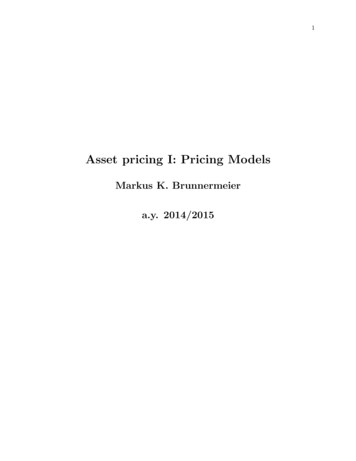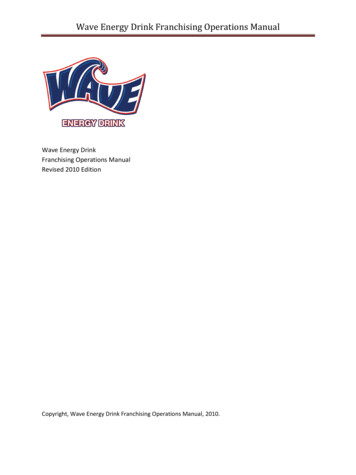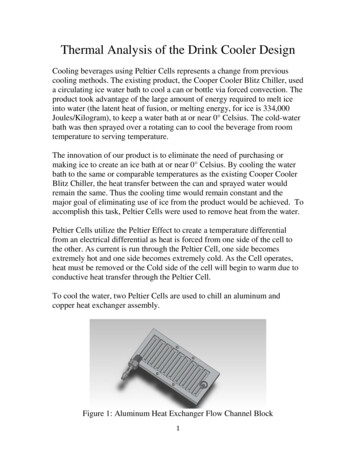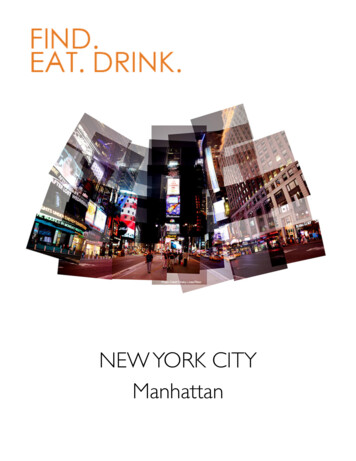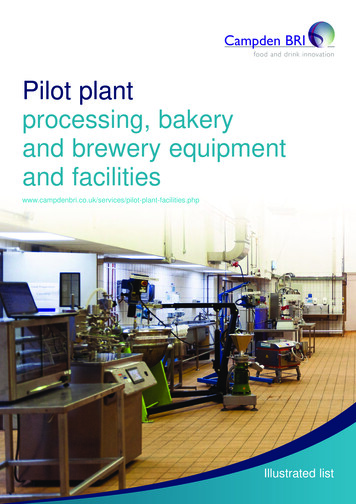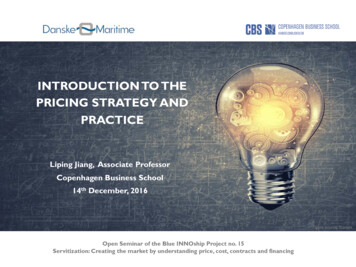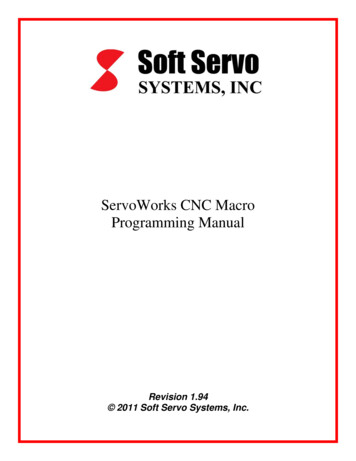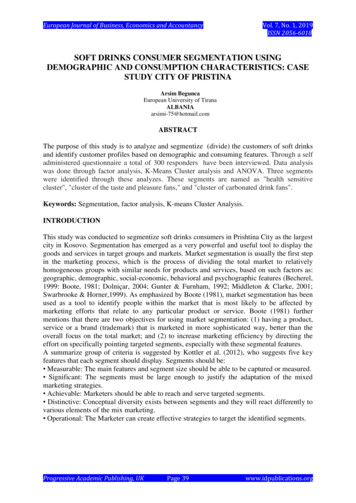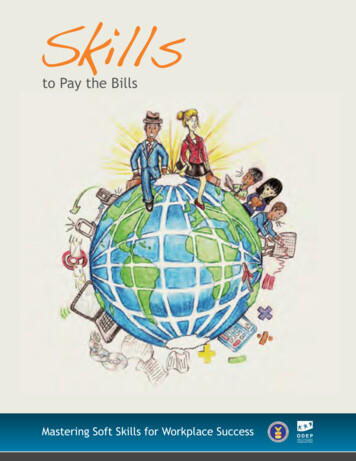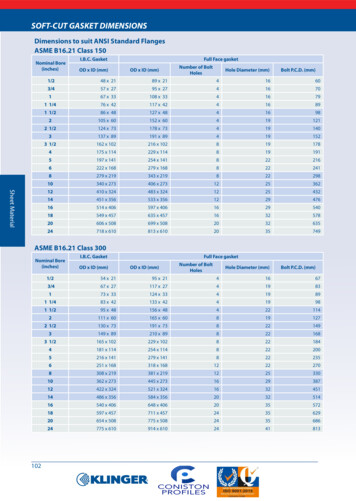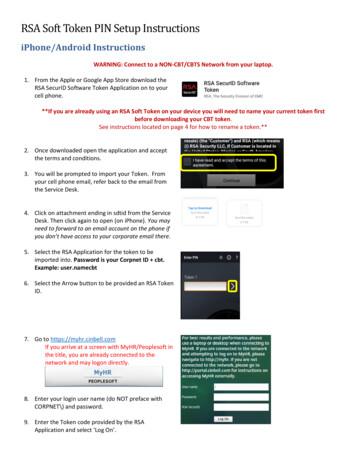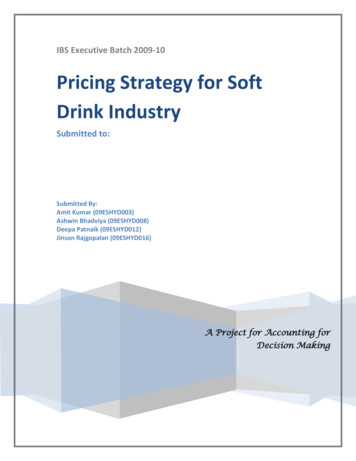
Transcription
IBS Executive Batch 2009-10Pricing Strategy for SoftDrink IndustrySubmitted to:Submitted By:Amit Kumar (09ESHYD003)Ashwin Bhadviya (09ESHYD008)Deepa Patnaik (09ESHYD012)Jinson Rajgopalan (09ESHYD016)A Project for Accounting forDecision Making
Table of ContentsIntroduction. 3Entry Barriers in Soft Drink Market . 3SWOT Analysis: . 4Various Cola Brands Products Available: . 5Pricing Strategy . 6Coke – Price. 6Pepsi – Price . 6Pricing strategy for Buyer and Suppliers . 6Effect of Competition and Price War on Industry Profits:. 7Pricing Strategy Used for Market Capitalization: . 7Penetration Pricing: . 8Conclusion:. 9
Soft drink IndustryIntroductionThe soft-drink industry comprises companies that manufacture nonalcoholic beverages andcarbonated mineral waters or concentrates and syrups for the manufacture of carbonatedbeverages.Soft drinks are available in glass bottles, aluminum cans and PET bottles for homeconsumption. Non-alcoholic soft drink beverage market can be divided into fruit drinks and softdrinks. Soft drinks can be further divided into carbonated and non-carbonated drinks. Cola,lemon and oranges are carbonated drinks while mango drinks come under non carbonatedcategory. Cola products account for over 60% of the total soft drink market and include popularbrands such as Coca-Cola, Pepsi, and Thumps up etc. Non-cola segment constitutes for over35% of the market.Until 1990s, domestic players like Parle Group (Thumps Up, Limca, Goldspot) dominated thesoft drink market in India. However, with the advent of the MNC players like Pepsi (1991) andCoke (re-entered in 1993 after it was banned in 1977) in the early 1990s, the market controlshifted towards them by the late 1990s.The per capita consumption of soft drinks in India is among the lowest in the world - 5 bottlesper annum compared to the 800 bottles per annum in the USA. Delhi reports the highest percapita consumption in the country – 50 bottles per annum. The consumption of PET bottles ismore in the urban areas [75% of total PET bottle (plastic bottles) consumption] whereas thesales of 200ml bottles were higher in the rural areas. According to a survey, 91% of the softdrink consumption in India is in the lower, lower middle and upper middle class section.Last one century witnessed the entry of various soft drink companies but only few of them wereable to survive. The major among them are COKE and PEPSI. These are the only twocompanies that has shared the whole market between them and left a very small share for theremaining ones. This made the word cola drink synonymous to the word soft drink.We will basically focus on the pricing strategies adopted by these two affluence companies, howthe change in the strategy of one of them reflects in the strategy of the other.Entry Barriers in Soft Drink MarketBefore coming on to the core topic of price strategy, we will discuss what are the factors thatmade the soft drink market a duopoly market.The several factors that make it very difficult for the competition to enter the soft drink marketinclude:
The factors that made the duopoly soft drink market and that make it very difficult for thecompetition to enter the soft drink market include:Network Bottling:Both Coke and PepsiCo have franchisee agreements with their existing bottler‟s who haverights in a certain geographic area in perpetuity. These agreements prohibit bottler‟s from takingon new competing brands for similar products. Also, with the recent consolidation among thebottler‟s and the backward integration with both Coke and Pepsi buying significant percent ofbottling companies, it is very difficult for a firm entering to find bottler‟s willing to distribute theirproduct.The other approach to try and build their bottling plants would be very capital-intensive effortwith new efficient plant capital requirements in 2009 being more than 500 million.Advertising Spend:The advertising and marketing spend in the industry is very high by Coke, Pepsi and theirbottler‟s. This makes it extremely difficult for an entrant to compete with the incumbents andgain any visibility.Brand Image / Loyalty:Coke and Pepsi have a long history of heavy advertising and this has earned them hugeamount of brand equity and loyal customer‟s all over the world. This makes it virtuallyimpossible for a new entrant to match this scale in this market place.Retailer Shelf Space (Retail Distribution):Retailers enjoy significant margins of 15-20% on these soft drinks for the shelf space they offer.These margins are quite significant for their bottom-line. This makes it tough for the newentrants to convince retailers to carry/substitute their new products for Coke and Pepsi.Fear of Retaliation:To enter into a market with entrenched rival behemoths like Pepsi and Coke is not easy as itcould lead to price wars which would affect the new comer.SWOT Analysis:Strength:PepsiCokePepsiCo brands enjoy a high-profile global presenceCoke brands enjoy a high-profile globalpresenceFour of the top five leading brandBroad-based bottling strategy47% of global volume sales in carbonatesndPepsi owns the world‟s 2 Best-Selling Soft Drinks brandConstant product innovationAggressive marketing strategies using famous celebrities
Weakness:PepsiCokeCarbonates market is in declinePepsi is the strongest in North AmericaThey only the target young crowdCarbonates market is in declineOver-complexity of relationship with bottlers in North AmericaExecution abilityOpportunities:PepsiCokeIncreased consumer concerns with regard to drinkingwaterGrowth in the functional drinks industrySoft drinks volumes in the Asia-Pacific region forecast toincrease by over 45%Brands like Minute Maid Light and Minute Maid PremiumHeart Wise are positioned well with the “Health-concerned”marketUse distribution strengths in Eastern Europe and LatinAmericaGrowth in RTD Tea , Asian Beverages and HealthierBeveragesThreats:PepsiCokeObesity and health concernsCoca-Cola increases marketing and innovationspending to 400M globallyGrowing "health-conscience" societyPepsiCo‟s Gatorade, Tropicana and Aquafina are strongerbrandsRelying only on North America.Boycott in the Middle East.Protest against coke in India.Various Cola Brands Products Available:Coca ColaPepsiLimca (1971)Sprite (1999)Low calorie cola Tab (1963)Diet Coke (1982)Caffeine free coke (1983)Coca-Cola classic (1985)New Coke (1985)Cherry Coke (1985)Thums Up (1977)Kinley (2001)Fanta (1993)Maaza (1993)Minute Maid Pulpy Orange(2008)Teem (1960)Mountain Dew(1964)Diet Pepsi (1964)Lemon Lime Slice (1984)Caffeine Free Pepsi Cola (1987)Sierra Mist (2000)Mountain Dew Code Red (2001)Pepsi one (2005)7 up (1984)Aquafina (2001)Mirinda (1993)Slice (1993)Mountain Dew MDX (2005)
Pricing StrategyIn economics and business, the price is the assigned numerical monetary value of a good,service or asset .Price is also central to marketing where it is one of the four variables (4 P‟snamely Product, Price, promotion, Place) in the marketing mix that business people use todevelop a marketing plan.Pricing is a big part of the marketing mix. Choosing the right price and the right pricing strategyis crucial to the marketing process. The price of the product is not something that is fixed .Onthe other hand the price of the product depends on many other factors .Sometimes the price ofthe product has got nothing to do with the actual product itself .The price may act as a way toattract target customers. The price of the product is decided keeping many things in mind.These things include factors like cost incurred on the product, target market, competitors,consumer buying capacity etc.Coke – PriceCoke was a company ruling the markets before Pepsi entered. Earlier the price of coke wascost based i.e. it was decided on the cost which was spent on making the product plus the profitand other expenses. But after the emergence of other companies especially the likes of Pepsi,Coca-cola started with a pricing strategy based on the basis of competition .Nowadays moreexpenses are spent on advertising by soft -drink companies rather than on manufacturing .Cokehas brought in a revolution especially in Indian markets with the Rs.5 pricing strategy which wasvery famous. It was the first company to introduce the small bottle of Coke for just Re.5 .Thiscampaign was very successful especially with the price conscious Indian consumers. Eventoday most prices of Coke are decided on the basis of the competition in the market.Pepsi – PricePepsi again decides its price on the basis of competition .The best think about the companyPepsi is that it is very flexible and it can come down with the price very quickly. The company isrenowned to bring the price down even up to half if needed. But this risk taking attitude has alsoearned Pepsi losses. Though lowering the price would attract the customers but it would nothelp them cover up the cost incurred in production hence causing them losses. This was thesituation earlier but now Pepsi is a full-fledged and growing company. It has covered all itslosses and is now growing at a rapid rate.Pricing strategy for Buyer and SuppliersSuppliers:The soft drink industry have a negotiating advantage from its suppliers as most of the rawmaterials needed to produce concentrate are basic commodities like Color, flavor, caffeine oradditives, sugar, packaging. The producers of these products have no power over the pricinghence the suppliers in this industry are weak. This makes the soft drink industry a cheap inputindustry which helps in increasing their gross margin.Buyers:The major channels for the Soft Drink industry are food stores, Fast food fountain, vending,convenience stores and others in the order of market share. The profitability in each of these
segments clearly illustrate the buyer power and how different buyers pay different prices basedon their power to negotiate.Food Stores:These buyers in this segment are somewhat consolidated with several chain stores and fewlocal supermarkets, since they offer premium shelf space they command lower prices, the netoperating profit before tax (NOPBT) for concentrate producer‟s is high.Convenience Stores:This segment of buyer‟s is extremely fragmented and hence has to pay higher prices.Fountain:This segment of buyer‟s are the least profitable because of their large amount of purchases theymake, it allows them to have freedom to negotiate. Coke and Pepsi primarily consider thissegment “Paid Sampling” with low margins. NOPBT in this segment is very low.Vending:This channel serves the customer‟s directly with absolutely no power with the buyer.Effect of Competition and Price War on Industry Profits: During 1960‟s and 70‟s coke and Pepsi adopted differentiation and advertising strategy.Pepsi came with “Pepsi challenge” strategy where blind taste test were hosted by Pepsiin order to differentiate itself as a better tasting product compare to coke.In the early 1990‟s Coke and Pepsi employed low price strategy in the supermarketchannel in order to compete with store brands.Coke and Pepsi however in the late 90‟s decided to abandon the price war, which wasnot doing industry any good by raising the prices.Coke was more successful internationally compared to Pepsi due to its early lead asPepsi had failed to concentrate on its international business after the world war and priorto the 70‟s. Pepsi however sought to correct this mistake by entering emerging marketswhere it was not at a competitive disadvantage with respect to Coke as it failed to makeany heady way in the European market.Pricing Strategy Used for Market Capitalization:Price is a very important part of the marketing mix as it can affect both the supply and demandfor soft drinks. The price of soft drinks products is one of the most important factors in acustomer„s decision to buy. Price will often be the difference that will push a customer to buy ourproduct over another, as long as most things are fairly similar. For this reason pricing policiesneed to be designed with consumers and external influences in mind, in order to effectivelyachieve a stable balance between sales and covering the production costs.Till the late 1980s, the standard SKU (Stock Keeping Unit) for a soft drink was 200 ml.
In 1989, when Indian government opened the market to multinationals, Pepsi was the first tocome in. Thums Up (a product of Parle) went up against the international giant for an intenseonslaught with neither side giving any quarter.Around 1989, Pepsi launched 250 ml bottles and the market also moved on to the new standardsize. When Coke re-entered India in 1993, it introduced 300 ml as the sm
Constant product innovation Broad-based bottling strategy Aggressive marketing strategies using famous celebrities 47% of global volume sales in carbonates . Weakness: Pepsi Coke Carbonates market is in decline Carbonates market is in decline Pepsi is the strongest in North America Over-complexity of relationship with bottlers in North America They only the target young crowd Execution
